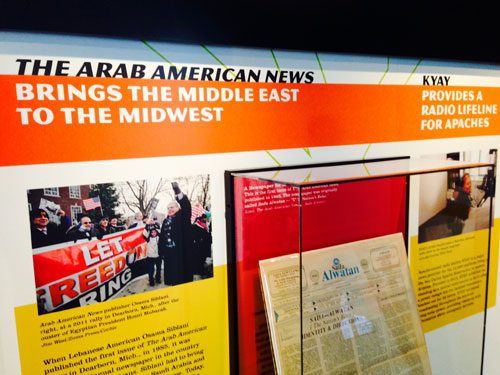
|
| The exhibit, entitled “One Nation with News for All” tells the story of The Arab American News Publisher, Osama Siblani, and how he launched the paper three decades ago. The publication was selected to participate in the exhibit for being a pioneer newspaper serving Arab Americans. Featured above is a copy of the paper’s first edition on glass display. PHOTOS: Courtesy of the Newseum. |
DEARBORN — A new exhibit at the Newseum in Washington D.C. tells the story of The Arab American News (TAAN), as a pioneer newspaper serving Arab Americans.
The exhibit entitled, “One Nation With News for All” is about the origins of ethnic media in the United States, and opened Friday, May 16.
It features the stories of 100 ethnic media outlets, both on the walls and in display cases in the gallery, as well as an interactive map that allows visitors to explore pioneering ethnic media, including newspapers, radio and TV stations and web-based news organizations.
One wall of the exhibit showcases the current front pages of various ethnic newspapers.
Thirty-six ethnic newspapers, including TAAN have agreed to participate, and the front covers of 10 of them are displayed and rotated each week.
The Arab American News is the only Arab American newspaper featured in the exhibit. The number of participating newspapers could grow throughout the duration of the exhibit, which ends Jan. 4, 2015.
“We made a conscious decision to make sure the media we selected were as unique and diverse as the people whose stories we chose to tell,” said Sharon Shahid, the Newseum’s online managing editor. “We focused on the ‘firsts,’ pioneers, groundbreakers, innovators and innovations — stories and people who had a lasting impact on journalism in general and the country as a whole and who continue to have an impact.”
TAAN was established in September 1984 and is preparing to celebrate its 30th anniversary. It has a weekly circulation of 35,000, and total readership of 140,000.
The paper serves metro Detroit’s Arab community and also reaches readers online. The region is home to the largest concentration of Arab Americans in the entire country, with 490,000 residing in it.
Osama Siblani, the publisher of TAAN said he did not expect the paper to garner that kind of success when he established it 30 years ago.
He added that the paper’s display at the Newseum is the result of the relentless work and commitment to reporting the truth and telling the Arab American story by people who contributed to the paper since it was founded.
“This is attributed to the dedicated employees who worked for the paper over the past three decades, to those who supported and believed in The Arab American News mission and mostly to the loyal readers who are a driving force behind our accomplishments,” he said. “We will continue to tell the truth and do our best to make the Arab American community proud.”
Every week since March, TAAN has sent a copy of the paper’s front cover to the Newseum.
As part of the project, the Newseum also asked for images of the paper’s publisher, contemporary images of newsroom activity or of reporters interacting with the community and covering the news.

TAAN was also asked for any old machines such as printing presses that were used decades ago when the paper first launched.
This week, as part of the exhibit’s opening, the front cover of one of TAAN’s most recent issues, in addition to the first copy of the paper, is featured.
It also tells the story of Siblani, and how he founded the paper.
The project is part of a partnership between the Newseum and Smithsonian Institution.
The Newseum is an interactive museum of news and journalism and features theaters and galleries. It has become one of the most popular attractions in Washington D.C.
The Smithsonian Institution is a group of museums and research centers administered by the United States government.
Shahid said Jim Duff, the Newseum’s CEO, and Wayne Clough, secretary of the Smithsonian, were instrumental in making the exhibit happen.
She said the Smithsonian’s Our American Journey project deals with the history of immigration and migration in the United States and news is an integral part of that story, so a collaboration between the two institutions made perfect sense.

“The fact that Newseum and Smithsonian Institute have partnered together to create this exhibit really shows how far we’ve come in recognizing the importance of ethnic and minority media in the U.S. But more work needs to be done,” said Elena Shore, an editor at New America Media (NAM), the country’s first and largest national collaboration and advocate of 3,000 ethnic news organizations.
Shore said ethnic media have responded to the recent demographic changes in the U.S. and play a crucial role in reaching growing immigrant and minority communities. She noted that at the same time, they receive a tiny percentage of advertising dollars, which is a critical means of survival.
Dr. Hayg Oshagan, the executive director of New Michigan Media, a network of ethnic and minority media across the state of Michigan, said ethnic media have always been key to the establishment and survival of ethnic communities.
“Through the stories and photos on their pages, ethnic media create a sense of community, a sense of shared lives for their readers which allows immigrants to feel membership in a community beyond their immediate family,” Oshagan said. “Ethnic media also help forge the new, American identity, while at the same time keeping alive an ethnic one. This is what America, a nation of immigrants, is all about, and it is this role of ethnic media in helping forge the vibrant American tapestry of ethnic diversity that the Newseum and Smithsonian are recognizing and celebrating.”
Ethnic media has been a force in the United States for several decades. Today, one in four Americans get their news from ethnic media, and that number is bound to grow as the minority population becomes the majority.
“We hope visitors come away from the exhibit with a clear understanding of the sacrifices made by immigrants and minorities in making the country so great,” Shahid said. “Their struggles, told through their own newspapers and broadcast outlets, laid the foundation for civil rights, equal rights and First Amendment rights. That’s as American a story as you can have.”
This is the first exhibit of the Newseum’s that tells the story of ethnic media so extensively, but it isn’t the first time the Newseum has dealt with the topic.
One of the stories in the Newseum’s News History Gallery, a permanent gallery, deals specifically with the minority press and its role in shaping the American experience. That story highlights the contributions of women as well as ethnic groups. Also, a new permanent exhibit, “Make Some Noise,” deals with the civil rights movement.
The project is the Newseum’s first partnership with the Smithsonian, which will also feature stories about the exhibit across its many print and online publications.
“One Nation With News for All” will only have a physical presence at the Newseum and won’t be displayed anywhere else.
While ethnic radio, TV and online outlets are represented in the exhibit, they are not showcased like the front pages. It was much easier to showcase front pages than feature electronic news outlets.
Khalil Abdullah, an editor at NAM’s Washington D.C. bureau, said the exhibit shows that there is recognition that the ethnic media sector is robust, and services a growing need.
“It has a vibrant, exciting, design that’s all-inclusive and truly shows the diversity of the country,” Shahid said.






Leave a Reply